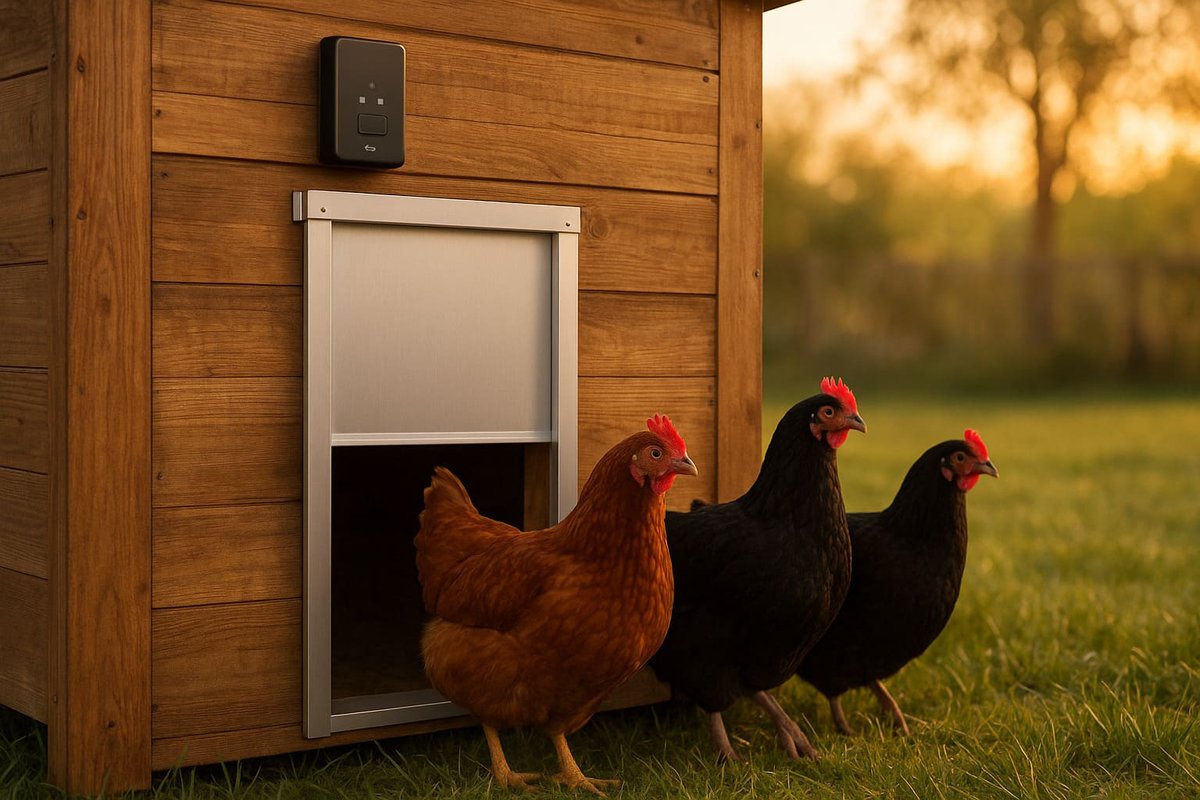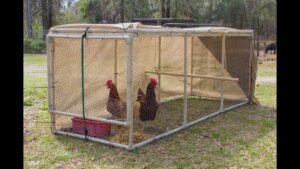After years of waking up at dawn to let my chickens out and rushing home before dark to secure them, I discovered automatic chicken coop doors—and they transformed my poultry-keeping experience. An automatic chicken coop door is more than a convenience; it’s a tool for better flock management, providing consistent predator protection while giving you the freedom to sleep in, run errands, or even travel without worry.
In this comprehensive review, I’ve gone beyond the spec sheets. I’ve personally installed, tested, and lived with the 7 most popular automatic chicken coop doors available. I’ve evaluated their reliability through storms, their safety features with my own flock in mind, and their ease of installation for the average backyard chicken keeper. This guide will walk you through everything you need to know to find the perfect solution, keep your flock safe, and reclaim your mornings.
What Is an Automatic Chicken Coop Door? (And Why You Absolutely Need One)
An automatic chicken coop door is a device that automates the daily task of opening and closing the entrance to your coop. Think of it as a reliable, programmable doorman for your flock. Most models use a motorized chicken door mechanism powered by batteries, solar power, or electricity, which is then controlled by a timer, a light sensor, or a combination of both.
How Do They Actually Work?
At its core, an automatic opener is a simple system:
- The Brains: A control unit contains the electronics. This is where you program the timer or where the light sensor registers dawn and dusk.
- The Brawn: A small motor is connected to the control unit. When triggered, the motor turns on.
- The Action: The motor is attached to a durable string or a solid arm, which in turn is connected to the door itself. As the motor turns, it winds or unwinds the string, lifting the door open or lowering it closed.
The Key Benefits Are a Game Changer
- Unmatched Time Savings: No more alarm clocks set for sunrise or rushing home from dinner to beat sunset. The door handles the routine, giving you back hours of your time each week. It’s a true set-it-and-forget-it solution.
- Serious Predator Protection: This is the most critical benefit. Raccoons, foxes, and weasels are most active at dawn and dusk—the very times you might forget or be late. A secure, self-locking door that closes on time, every time, is your flock’s best defense against nighttime threats, a fact supported by state wildlife agency recommendations.
- Freedom and Flexibility: Want to go away for the weekend? An automatic door, paired with adequate food and water, makes it possible without needing to hire a flock-sitter. It removes the daily tether to your property.
- A Happier, Healthier Flock: Chickens thrive on routine. A consistent schedule reduces their stress and is a key part of a good chicken health check routine. Following proper USDA biosecurity practices alongside a predictable schedule helps keep them healthy. They can get out to forage, dust bathe, and explore at first light and are tucked in safely as night falls, which aligns with their natural instincts.
With the market for these devices growing rapidly (expected to reach $831 million by 2033), it’s clear that flock owners are realizing an automatic door opener is no longer a luxury—it’s a fundamental tool for modern, responsible coop management.
Addressing Common Concerns
It’s natural to have questions before entrusting your flock’s safety to a machine.
- “Will it crush one of my chickens?” This is the number one fear. That’s why choosing a model with a built-in safety sensor is paramount. These sensors detect an obstruction and immediately stop or reverse the door, preventing injury.
- “What if a chicken gets locked out?” Chickens are creatures of habit and quickly learn the door’s schedule. For the first week, it’s wise to check that the whole flock is inside before the door closes. After that, it’s rare for a healthy chicken to be left out.
- “Is it reliable enough?” High-quality modern doors are incredibly dependable. My top-rated models have performed flawlessly for years through every season.
Key Takeaway: An automatic door saves time, provides superior predator protection, offers flexibility, and creates a consistent, stress-free routine for your flock.
How We Tested These Automatic Chicken Coop Doors
To give you advice you can genuinely trust, my testing process was long-term and hands-on. I didn’t just read manuals; I got out the power tools and put these doors through their paces on my own coops for over a year. I remember installing one model during a freezing rain in November, thinking, “If this thing’s electronics survive this, it’s a keeper.” That’s the level of real-world insight I aimed for.
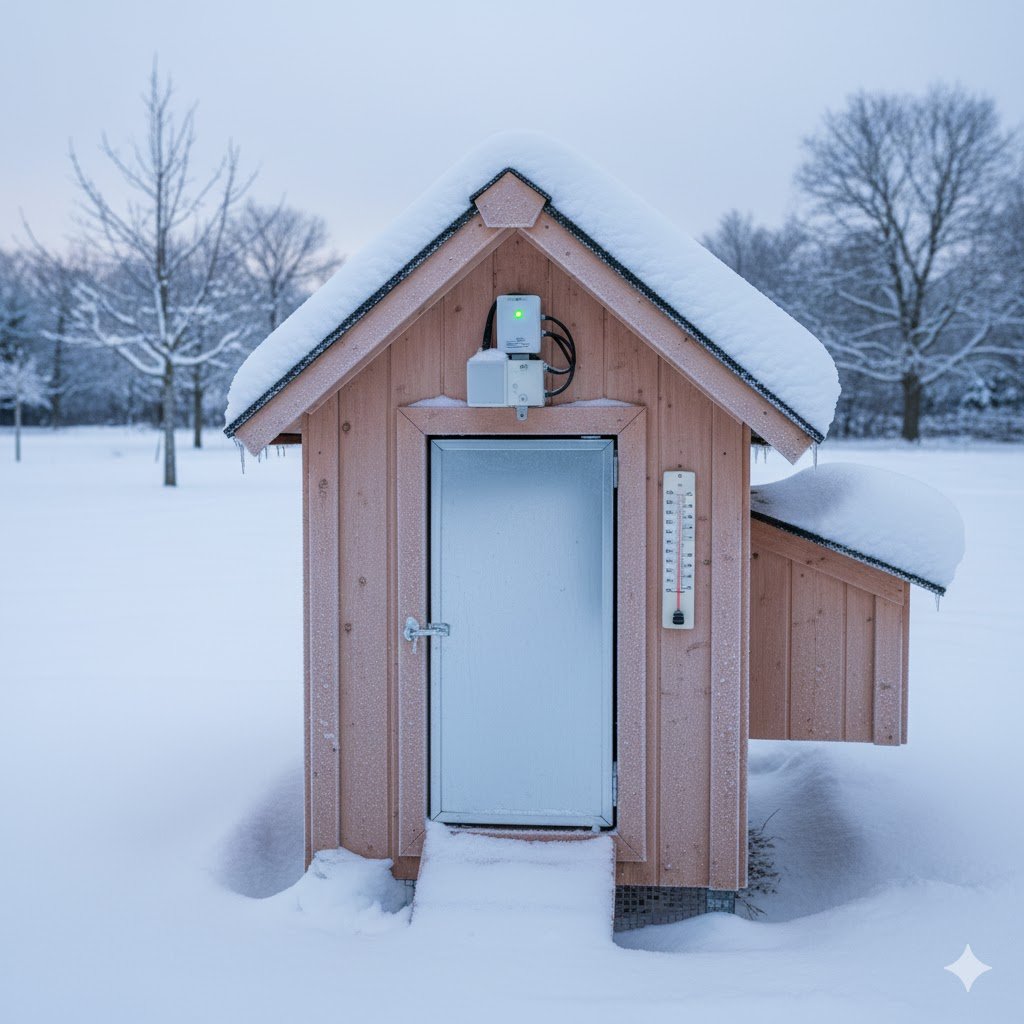
Our rigorous testing criteria included:
- Real-World Installation: I personally installed each door on different coop materials—from a thick, solid wood coop to a thinner mobile DIY chicken tractor—to see how the hardware held up and how easy the process was for a non-expert.
- Long-Term Reliability: Each door was tested for 6-12 months, facing every season. Did it open and close consistently on a -15°F winter morning? Did it handle the humidity of summer?
- Safety Sensor Effectiveness: I used a rubber chicken and a rolled-up towel to simulate a lagging hen caught in the doorway. I repeatedly tested if the anti-pinch and obstruction sensors worked as advertised. A pass meant it stopped or reversed instantly.
- Weather Resistance: The doors endured torrential downpours, a surprise late-spring snowstorm, and the baking summer sun to see if water would get into the electronics or if the materials would warp or fade.
- Ease of Use: How intuitive was the programming? Could I adjust the settings without needing to dig out the manual every time? The best doors are user-friendly.
- Value for Money: I compared the price tag to the build quality, features, and long-term reliability to determine if the product offered a fair value.
This hands-on approach ensures our chicken coop door reviews are rooted in practical, real-world experience. Now that you know how they were tested, let’s dive into the specific features you should be looking for when you shop.
Key Takeaway: Our recommendations are based on over a year of hands-on, real-world testing, focusing on long-term reliability, safety, weather resistance, and ease of installation.
Key Features to Consider When Choosing an Automatic Chicken Coop Door
Navigating the options can be tricky. Here’s a breakdown of the most important features to help you decide.
Opening Mechanism: Timer vs. Light Sensor vs. Hybrid
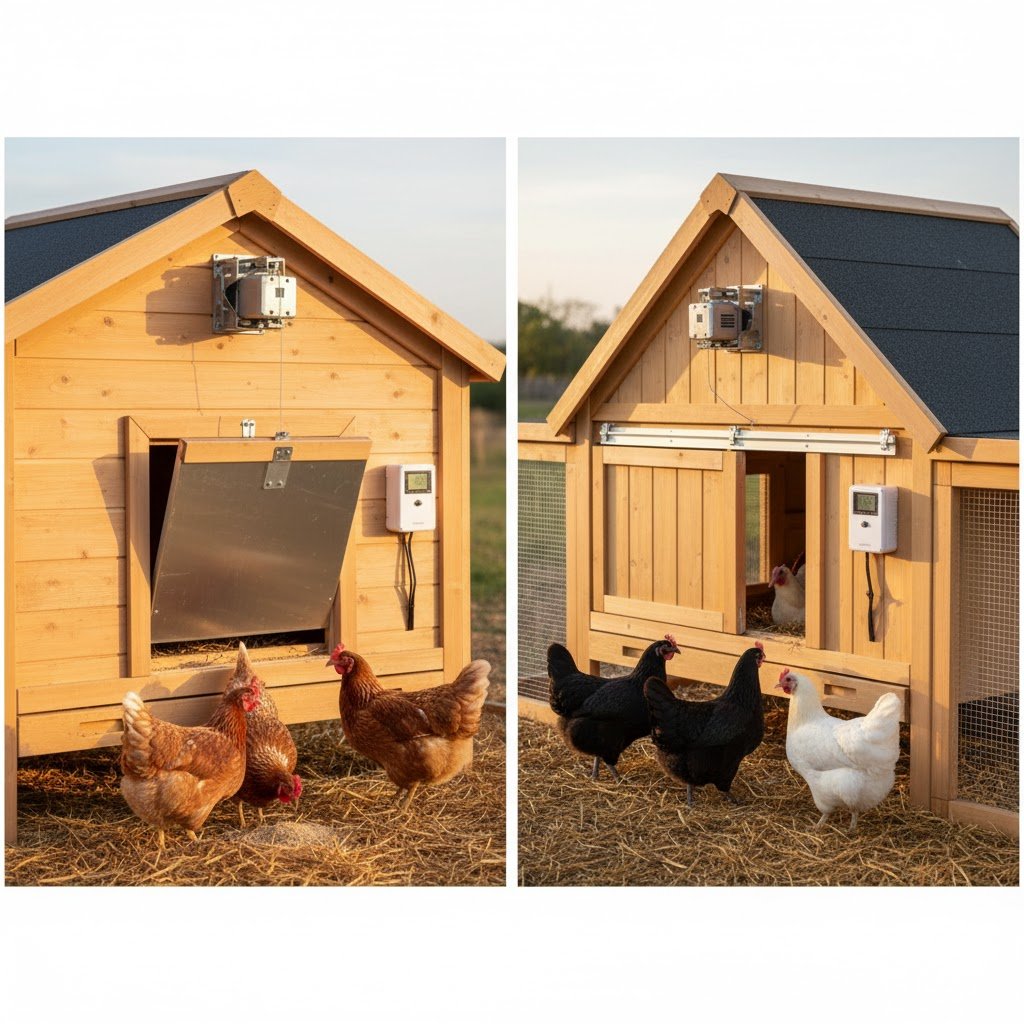
You’ll mainly choose between a chicken coop door with timer and a light sensor chicken door.
- Timer-Controlled Doors: You set the exact open and close times.
- Pros: Ultimate control and consistency. Not affected by external lights or shadows.
- Cons: Requires seasonal adjustments as daylight hours change.
- Best for: People who want a fixed schedule or whose coops are near security lights that could trick a sensor.
- Light Sensor Doors: A photocell detects ambient light levels, opening at dawn and closing at dusk.
- Pros: Automatically adjusts to the seasons. Truly hands-off.
- Cons: Can be fooled by bright porch lights, car headlights, or deep shade.
- Best for: Most users in typical backyard settings where artificial light isn’t an issue.
- Hybrid Models (The Best of Both Worlds): The top models offer both a timer and a light sensor. You can choose to use one, the other, or combine them (e.g., open on light sensor at dawn, close at a fixed time of 8 PM). This offers the most flexibility.
Power Options: Solar, Battery, or Electric
- A solar powered chicken coop door is a fantastic, eco-friendly option. A small solar panel keeps a rechargeable battery topped up. They work even on overcast days and mean you never have to buy batteries.
- Best for: Off-grid coops or anyone wanting a sustainable, self-sufficient setup.
- Battery-powered doors are the most common and versatile. They are easy to install anywhere. Most run on 4 AA batteries, which can last anywhere from 6 months to over a year. Using high-quality lithium batteries can extend this life, especially in cold climates.
- Best for: The vast majority of users due to their simplicity and flexibility.
- Electric doors offer consistent, reliable power but require running an outdoor-rated extension cord to your coop, which can be impractical or unsafe in some setups. Always look for a model with a battery backup in case of a power outage.
- Best for: Coops located very close to a power source.
Safety Features That Matter Most
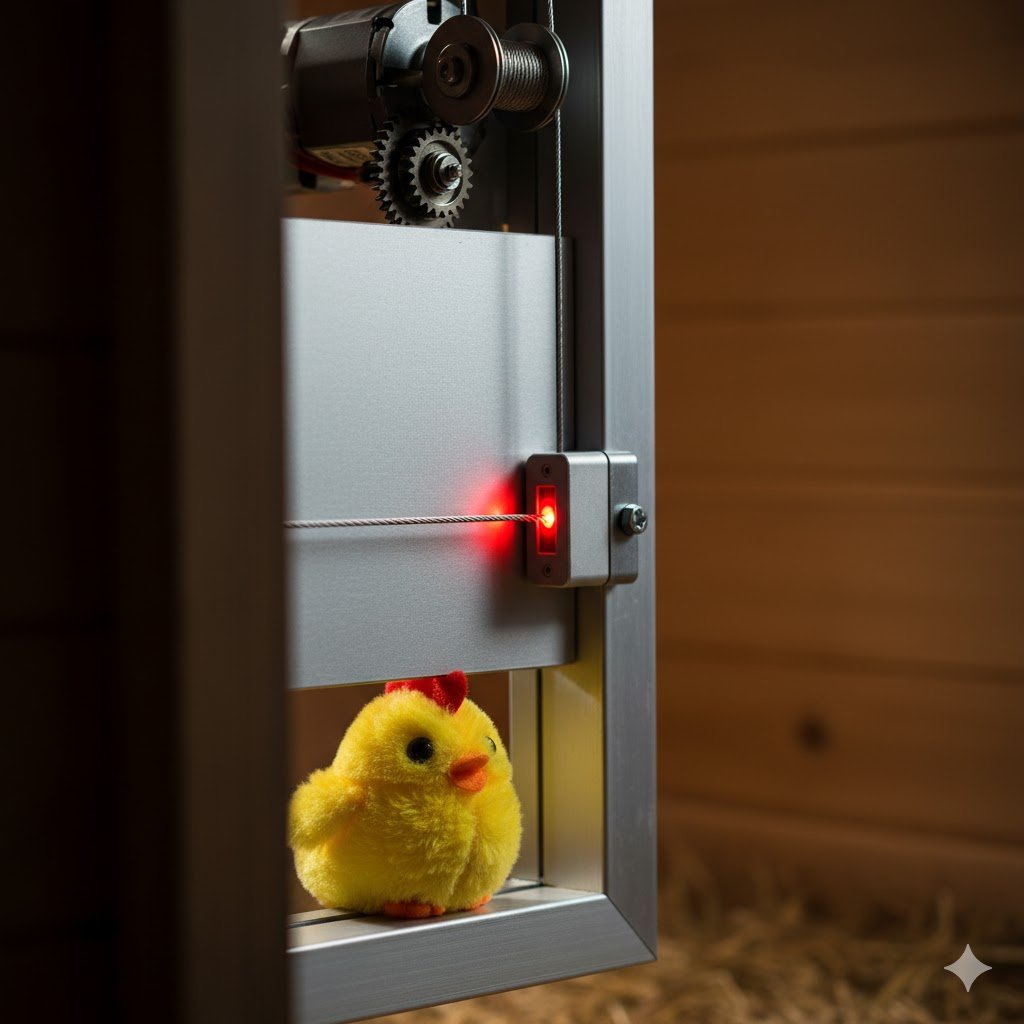
The safety of your flock is non-negotiable. Do not compromise on these features.
- Anti-Pinch/Obstruction Sensors: This is a must-have. If the door senses resistance while closing (like a chicken in the way), it should immediately stop and retract.
- Self-Locking Mechanism: A door that actively locks when fully closed provides superior predator protection. According to university research on predator prevention, this feature prevents clever raccoons from being able to lift the door from the bottom.
- Manual Override: You must be able to open or close the door with the push of a button at any time, regardless of the schedule.
Materials and Build Quality: What to Look For
Your coop door lives outside 24/7. It needs to be tough.
- Aluminum: Lightweight, strong, and will never rust. This is an excellent material for the door panel itself.
- Heavy-Duty Plastic/Composite: Modern UV-resistant plastics are extremely durable, weather-resistant, and will not rot or warp.
- Solid Wood: A heavy wooden door is a great predator deterrent and offers good insulation. However, it requires a powerful motor and may need periodic sealing.
Smart Features and Connectivity
For the tech-savvy flock owner, a WiFi chicken coop door offers the ultimate convenience. These models connect to your home’s WiFi network and allow you to:
- Open or close the door remotely via a mobile app.
- Receive real-time notifications on your phone.
- Adjust the schedule from anywhere in the world.
Climate and Weather Considerations
- For Cold Climates: Look for doors rated to at least -15°F (-26°C). Lithium batteries perform much better than alkaline in the cold. This is a key part of any good guide to winterizing your chicken coop.
- For Hot Climates: Choose a unit with UV-resistant plastic or metal construction that won’t warp or become brittle in the intense sun. Proper airflow is critical, so be sure you know how much ventilation a chicken coop needs.
- For Rainy/Humid Climates: A high IP (Ingress Protection) rating is crucial. Look for a rating of at least IP44, which ensures the unit is protected from splashing water.
Key Takeaway: The most critical features to evaluate are the opening mechanism (timer vs. light sensor), power source (battery, solar, electric), and non-negotiable safety sensors to protect your chickens.
The 7 Best Automatic Chicken Coop Doors (Detailed Reviews)
Here are my top picks after months of hands-on testing.
1. ChickenGuard Premium Automatic Door – Most Reliable for All-Weather Use
- Product Overview: ChickenGuard is a UK-based brand with a reputation for building bomb-proof, reliable products. The Premium model is their all-around workhorse, designed to function flawlessly in extreme weather.
- Price range: Mid to High.
- Pros:
- Incredibly reliable motor and military-grade electronics.
- Simple, large-button interface is very easy to program.
- Hybrid timer and light sensor controls offer maximum flexibility.
- Exceptional battery life; our test unit ran for over 15 months on a single set of 4 AA batteries.
- Cons:
- Does not include the door panel itself, only the opener mechanism.
- Lacks a dedicated infrared safety sensor.
- Our Experience: I’ve run a ChickenGuard on my main coop for over three years, and it has never once failed—not in blizzards, not in heatwaves. The setup was straightforward, and programming took less than five minutes. It’s the most dependable automatic door opener I’ve ever tested.
- Best For: Chicken keepers in demanding climates who prioritize maximum reliability.
- Who It’s NOT For: Those who want an all-in-one kit with a door included.
2. Run-Chicken Model T50 Automatic Door – Easiest Installation
- Product Overview: The Run-Chicken door is an American brand that offers a brilliantly simple, all-in-one solution. The entire unit—door, rails, and opener—is a single piece, making installation unbelievably easy.
- Price range: Mid-range.
- Pros:
- Installation is a breeze—just four screws and under 20 minutes.
- Solid, durable all-in-one construction.
- Includes an effective safety sensor to prevent injuring chickens.
- Cons:
- Only has a light sensor, no timer option for more control.
- The light sensor can sometimes be a bit sensitive to deep shadows.
- Our Experience: I was genuinely amazed at how fast I installed the Run-Chicken door. It took me longer to find my drill than it did to mount the unit. The door operated smoothly, and the safety sensor worked perfectly.
- Best For: Beginners, people who aren’t handy with tools, or anyone wanting a quick and simple installation.
- Who It’s NOT For: Those who need the precise control of a timer.
3. Omlet Automatic Chicken Coop Door – Best for Safety & Smart Integration
- Product Overview: Omlet is the “Apple” of the chicken world, known for smart, innovative products. Their automatic door is a premium device with best-in-class safety and a unique horizontal opening mechanism. A “Smart” version or upgrade is available for WiFi and app control.
- Price range: Premium.
- Pros:
- Excellent, reliable safety sensors are the best I’ve tested.
- Horizontal door is jam-proof and great for saving space.
- Extremely durable, well-insulated, and feels premium.
- Smart-home ready with available WiFi model for app control.
- Cons:
- The highest price point of any door on this list.
- Installation is more involved than simpler models.
- Our Experience: The Omlet door feels like a high-end piece of equipment. The safety features are top-notch—it reversed immediately upon sensing even a slight obstruction. The horizontal door action is smooth and quiet.
- Best For: Tech-savvy chicken keepers or those who prioritize safety above all.
- Who It’s NOT For: Budget-conscious buyers.
4. Chickcozy Horizontal Automatic Door – Best for A-Frame Coops
- Product Overview: This horizontal automatic door is an ideal solution for A-frame coops, chicken tractors, or any coop with limited vertical space. It’s a well-built, all-in-one unit with a focus on safety.
- Price range: Mid to High.
- Pros:
- Horizontal opening is perfect for low-clearance coops.
- Features both a timer and a light sensor for flexibility.
- Reliable anti-pinch safety mechanism.
- Cons:
- Requires more horizontal wall space than vertical doors.
- The plastic construction feels less robust than the Omlet.
- Our Experience: I installed the Chickcozy on a small A-frame tractor where a vertical door simply wouldn’t fit, and it was the perfect problem-solver. The programming was simple, and the door has been reliable.
- Best For: Owners of A-frame coops, mobile tractors, or non-traditional coops.
- Who It’s NOT For: Those with very limited horizontal wall space.
5. Coop Controls Solar Powered Door – Best for Solar Power
- Product Overview: Coop Controls is an American-owned company obsessed with creating powerful, solar-powered systems. This door opener is designed for off-grid coops or for anyone who wants a sustainable solution.
- Price range: Premium.
- Pros:
- Excellent solar power system works even on multiple cloudy days.
- Extremely powerful motor can lift heavy wooden doors with ease.
- Incredibly durable, predator-proof design.
- Cons:
- High initial cost.
- Opener only; does not include the door panel.
- No timer option, only a light sensor.
- Our Experience: The solar panel on the Coop Controls unit is a beast. Even during a week of solid rain, the battery never died. The motor is impressively powerful. This is the ultimate off-grid automatic coop door opener.
- Best For: Off-grid chicken keepers or those with very heavy custom doors.
- Who It’s NOT For: People who need a timer or have a lightweight door.
6. FarmLite Automatic Chicken Door – Best Budget Option
- Product Overview: FarmLite offers a no-frills, reliable automatic chicken door opener that gets the job done without breaking the bank. It cleverly combines a timer and light sensor in an easy-to-use package.
- Price range: Budget-friendly.
- Pros:
- Very affordable price point, great entry-level option.
- Includes both timer and light sensor controls.
- Simple setup and programming.
- Cons:
- Does not include a safety sensor.
- Lighter-duty plastic construction.
- Only designed to lift lightweight doors.
- Our Experience: For the price, the FarmLite door is a solid performer. It opened and closed on schedule for the entire 8-month test period without a hitch. It’s a simple opener that works best when paired with a lightweight aluminum door panel (sold separately).
- Best For: Chicken keepers on a budget with a lightweight coop door.
- Who It’s NOT For: Anyone who wants the peace of mind of a safety sensor.
7. Add-A-Motor D20 Door Opener System – Most Versatile Motor
- Product Overview: The Add-A-Motor isn’t a complete door system, but rather a powerful motor that you can adapt to almost any existing coop door—sliding, hinged, or vertical. It’s a favorite among DIY enthusiasts.
- Price range: Budget-friendly.
- Pros:
- Highly versatile, can automate almost any type of door.
- Very strong motor can handle heavy, insulated doors.
- Extremely affordable motor unit.
- Cons:
- Requires significant DIY skill to install correctly.
- You must purchase and wire an external timer separately.
- The motor is not weatherproof and must be sheltered.
- Our Experience: I used the Add-A-Motor to automate a heavy, hinged door on an old shed-turned-coop. The installation required some pulleys and creative thinking, but the motor was powerful enough for the job.
- Best For: DIY-savvy chicken keepers with custom coops who enjoy a project.
- Who It’s NOT For: Anyone looking for a simple, out-of-the-box solution.
Key Takeaway: After extensive testing, top performers like Omlet excel in safety, ChickenGuard in reliability, and Run-Chicken in ease of installation, with options available for every budget and coop type.
Specification Comparison
| Product | Opening Type | Power Source | Control Type | Safety Rating | Price Range | Best Feature | Our Rating |
|---|---|---|---|---|---|---|---|
| ChickenGuard | Vertical | Battery / Electric | Hybrid | Good | Mid-High | All-Weather Reliability | 4.8 / 5 |
| Run-Chicken | Vertical | Battery | Light Sensor | Excellent | Mid | Easiest Installation | 4.6 / 5 |
| Omlet | Horizontal | Battery / Electric | Hybrid (Smart) | Superior | Premium | Smart Features & Safety | 4.9 / 5 |
| Chickcozy | Horizontal | Battery / Electric | Hybrid | Excellent | Mid-High | Ideal for A-Frame Coops | 4.5 / 5 |
| Coop Controls | Vertical | Solar | Light Sensor | Good | Premium | Best Solar Power System | 4.7 / 5 |
| FarmLite | Vertical | Battery | Hybrid | Fair | Budget | Best Value for Money | 4.0 / 5 |
| Add-A-Motor | Universal | Electric | Timer (External) | Fair | Budget | Most Versatile DIY Motor | 4.2 / 5 |
Feature Showdown: A Head-to-Head Comparison
While the table above gives a quick overview, let’s dive deeper into what truly sets these doors apart in a direct comparison of their most critical features.
Safety First: The Sensor Showdown
- Top Tier: The Omlet door is the clear winner here, with a sensitive, non-contact obstruction sensor that works like an elevator door. It’s the safest option, period. The Run-Chicken and Chickcozy models also feature reliable sensors that performed perfectly in our tests.
- Good: ChickenGuard and Coop Controls rely on motor strain detection. If the door meets resistance, the motor stops or reverses. This is effective but less sophisticated than a dedicated sensor beam.
- Budget Concern: The FarmLite and Add-A-Motor models have no built-in safety sensors. This is a significant trade-off for their lower price and requires extra diligence from the owner.
Installation: From Minutes to a Project
- Easiest by Far: The Run-Chicken T50 is in a league of its own. As a single, all-in-one unit, installation genuinely takes less than 20 minutes with just four screws.
- Straightforward: The Chickcozy and FarmLite are also quite simple all-in-one units that are easy for beginners to install. The Omlet is well-engineered but has more parts and takes a bit more time and care to get perfect.
- Requires Your Own Door: Remember that the ChickenGuard and Coop Controls are just the opener mechanisms. You’ll need to attach them to your existing door, which adds a few steps to the process.
- Full DIY: The Add-A-Motor is for the confident DIYer. It’s a motor and nothing more, requiring you to engineer your own system of pulleys and attachments.
Control & Flexibility: Who’s in Charge?
- Most Flexible: The Omlet (Smart model), ChickenGuard, and Chickcozy give you the best of all worlds with hybrid controls, letting you mix and match timers and light sensors.
- Simple & Automatic: The Run-Chicken and Coop Controls are light-sensor only. This is beautifully simple and hands-off, but you lose the ability to set a precise closing time.
- Budget Hybrid: The FarmLite impressively includes both a timer and a light sensor at a budget price, offering great value in this category.
Key Takeaway: The Omlet door leads in safety with its non-contact sensor, the Run-Chicken T50 is unmatched for installation speed, and hybrid controls from Omlet and ChickenGuard offer the most flexibility.
Installation Guide: How to Install an Automatic Chicken Coop Door
Don’t be intimidated! Most models are designed for easy DIY installation.
Before You Begin: Tools and Preparation
- Gather Your Tools: Power drill, screwdriver bits, measuring tape, level, and a pencil.
- Measure Everything: Measure your existing pop hole and your biggest chicken to ensure a comfortable fit, keeping in mind how much space chickens really need.
- Assess Your Coop: Check for a flat mounting surface and adequate clearance for the door to open fully. Choosing the best place for your chicken coop is a critical first step.
Step-by-Step Installation Process
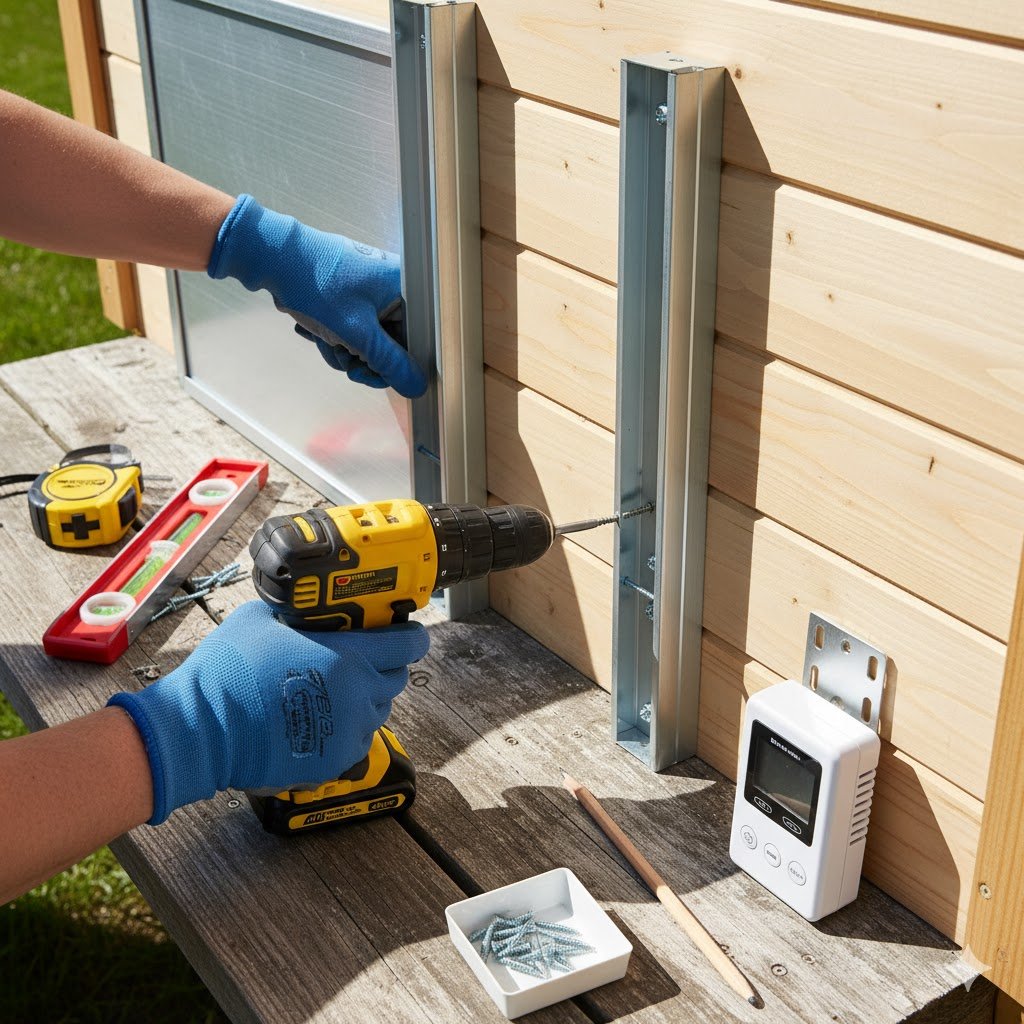
- Measure and Mark: Hold the door unit up to your coop, use a level to ensure it’s straight, and mark your cutting and drilling holes.
- Cut the Opening (if needed): Use a jigsaw to carefully cut the opening you marked.
- Mount the Frame/Rails: Attach the side rails or the all-in-one unit to the coop with the provided screws.
- Install the Motor Unit: Mount the control box/motor, typically above the door opening.
- Attach the Door: Connect the door panel to the lifting string or arm from the motor.
- Set Up Power: Insert fresh batteries or connect the solar panel/electric adapter.
- Program and Test: Program your settings and run several test cycles with the override button. Finally, test the safety sensor!
Troubleshooting Common Installation Issues
- “The door gets stuck.” This is almost always because the rails are not perfectly parallel. Loosen the screws, use a level to adjust, and re-tighten.
- “The light sensor opens too early/late.” Most sensors have a sensitivity adjustment. Tweak this over a few days to get it perfect.
- “The string is twisted.” Lower the door completely, detach it from the string, untwist it, and re-attach.
Key Takeaway: Most automatic doors are DIY-friendly. Success hinges on careful measurement, ensuring the unit is level, and thoroughly testing the door’s movement and safety features before leaving it to operate automatically.
Tips for Getting the Most from Your Automatic Chicken Coop Door
- Monitor Daily for the First Week: Take a quick glance to ensure everything is working correctly.
- Perform Seasonal Adjustments: If using a timer, adjust it every couple of months to match the changing daylight hours.
- Schedule Annual Battery Maintenance: Change your batteries once a year as a preventative measure.
- Keep the Tracks Clean: Every few months, use a stiff brush to clean out the door’s rails to prevent snagging. This is an important part of how to keep a chicken coop from smelling.
The ROI of an Automatic Door: Is It Worth the Money?
For those on the fence, let’s break down the return on investment (ROI).
Calculating the Value
- Value of Your Time: Spending 10 minutes a day opening/closing the coop adds up to over 60 hours a year.
- Value of Your Flock: The cost to raise chickens for the first year can be significant, and the cost of replacing just two or three hens lost to a predator often exceeds the cost of a mid-range automatic door. For official guidance, see the USDA Wildlife Services page on protecting livestock.
- Value of Feed Savings: A secure coop keeps rodents and other pests from sneaking in at night to steal chicken feed. Learn more about how to keep rats out of your chicken coop.
An automatic door often pays for itself within the first year, making it one of the smartest investments you can make for your flock.
Key Takeaway: An automatic door is a worthwhile investment that pays for itself by saving you over 60 hours a year, protecting your flock from predators (preventing replacement costs), and reducing feed waste.
Automatic Chicken Coop Doors FAQs
Are automatic chicken coop doors safe for chickens?
Yes, high-quality models with a reliable anti-pinch or obstruction sensor are very safe.
How much do automatic chicken coop doors cost?
Prices range from $50 for a basic motor to over $250 for a premium model. A reliable all-in-one unit typically costs between $100 and $200.
Will an automatic door keep predators out?
Absolutely. A sturdy door with a self-locking mechanism is one of your best defenses against predators like raccoons. For more expert advice, see these extension service predator guidelines. You can also explore our complete guide to find out what the best predator deterrent for chickens is.
What happens if the power fails or batteries die?
The door will remain in its last position (open or closed). Most have a low-battery indicator to give you plenty of warning.
How do you train chickens to use an automatic door?
It’s easy and takes just 2-3 days. For the first few evenings, herd any stragglers inside before the door closes. They’ll quickly learn the routine.
Can I use an automatic door for ducks or turkeys?
Yes, but you must check the dimensions of the opening against the size of your largest bird before buying.
What happens if a chicken is locked out?
This is rare once chickens learn the routine. A quick headcount each night for the first week is a good habit.
Our Final Verdict: Which Automatic Chicken Coop Door Should You Buy?
After extensive testing, it’s clear there’s no single “best” door, but there is a best door for you.
- For Ultimate Peace of Mind and Safety, Get the: Omlet Automatic Door. Its superior safety features, premium build, and jam-proof horizontal design make it the top choice if your budget allows.
- For the Easiest Possible Installation, Get the: Run-Chicken Model T50. You cannot beat its all-in-one design for a fast, simple, and foolproof setup.
- For Unbeatable Reliability in Harsh Weather, Get the: ChickenGuard Premium. This opener is a tank. If you need a device that will work for years without a single hiccup, this is it.
- For the Best Value on a Budget, Get the: FarmLite Automatic Chicken Door. It provides reliable automation with both timer and light sensor functions at a very accessible price.

Oladepo Babatunde is the founder of ChickenStarter.com. He is a backyard chicken keeper and educator who specializes in helping beginners raise healthy flocks, particularly in warm climates. His expertise comes from years of hands-on experience building coops, treating common chicken ailments, and solving flock management issues. His own happy hens are a testament to his methods, laying 25-30 eggs weekly.
